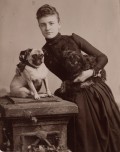The Taylor Family Collection
Throughout her life, Lillian Gary Taylor kept careful records of nearly everything—from her experiences traveling in Europe to her extensive collection of best-selling American fiction. Her various and diverse records include Memories, her five-volume autobiography; her Collecting Journals, in which she tracked her literary acquisitions; and her correspondence regarding her collection. These documents not only provide insight into Lillian’s personal life, but also reveal important facets of American life in the late nineteenth and early twentieth centuries.
Both Memories and Lillian’s Collecting Journals are eclectic and fascinating documents. Memories consists of five hand-written volumes, recounting Lillian’s life from early childhood memories through her experience of traveling in Austria during the outbreak of World War I. She writes of such fascinating experiences as meeting the Greely Arctic Expedition; acting as her father’s hostess in Washington, D.C., while he was Postmaster General for President McKinley; and watching the construction of the Panama Canal in 1912. Also inserted in Memories are photographs, menu cards, letters, and illustrations drawn by Lillian. Her stories and the inserted documents open a window into high-society life in Baltimore, New York City, and Europe at the turn of the century.
Lillian’s Collecting Journals record and elaborate on her collection of best-selling American fiction. The collection originally included over 1900 volumes published between 1787 and 1945, and was donated to the University of Virginia in 1945. While the collection itself has continued to grow through the Robert Coleman Taylor Endowment, Lillian’s Collecting Journals include entries for bestsellers from 1787 through 1947. Through these journals, Lillian documents reading trends in her lifetime as well as in the Early Republic. For each book, she would meticulously hand-copy the title page, and record the volume’s condition, provenance, worth, and any other information she could add, such as reviews and sales. Through these documentary concerns, Lillian reveals what interested readers from the late eighteenth century through the mid-twentieth century.

